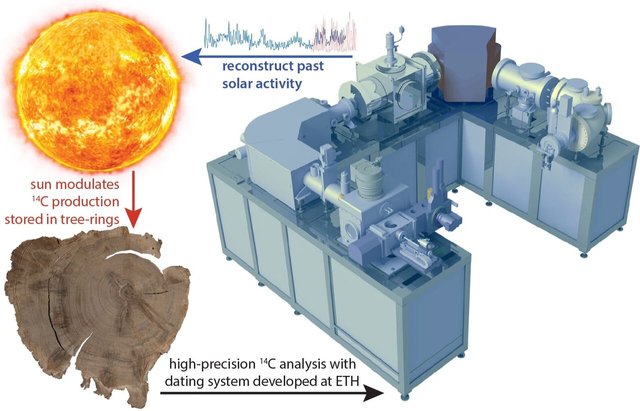Solar Activity of Thousand Years
Solar activity reconstructed thanks to radiocarbon measurements in tree rings: the data will help to better understand the dynamics of the Sun.

Credits
What happens inside the Sun can only be studied indirectly, and only starting from what is observed on its surface. The sunspots they are an example: they are areas of the Sun's surface that are distinguished from neighboring ones because they are darker, due to the lower temperature and greater magnetic activity; following their succession it is possible to know something more about what happens inside our star: the more sunspots are visible on the surface of the Sun, the more active the Sun is, even in the innermost regions. Although sunspots have been known since ancient times, they have only been documented in detail since the invention of the telescope some 400 years ago. Thanks to the observations made in these four centuries we know that the number of spots varies in regular cycles of eleven years and that, moreover, there are periods of strong solar activity which alternates with periods of weak activity., periods that, according to some research, could also have repercussions on the climate on Earth.
CYCLES UP TO 969 RECONSTRUCTED
How solar activity developed 400 years ago has so far been difficult to reconstruct, but a recent study by an international research group has managed to reconstruct the Sun's 11-year cycle up to year 969 AD using measurements of the radioactive carbon concentration present in tree rings . The study is published in Nature Geoscience .
THE ARCHIVE OF THE RINGS
To reconstruct solar activity over the course of a millennium, the researchers used tree-ring archives from England and Switzerland. In those rings, the age of which can be precisely determined by counting the rings themselves, there is a tiny fraction of radioactive carbon , carbon-14 (radiocarbon). The data of the half-life (ie the time required for the radioactivity to halve) of the isotope C-14, about 5,570 years, allows us to deduce the concentration of radioactive carbon in the atmosphere when a certain growth ring has formed. Since radioactive carbon is mainly produced by cosmic particles, which in turn are kept away from the Earth to a greater or lesser extent by the Sun's magnetic field, it is possible to deduce in which years it has been more or less active.

Credits
NEW METHODS
The precise measurement of the C-14 concentration is extremely complex, because we are talking about very small quantities. Lukas Wacker, one of the authors of the research, explains: «The only measurements of this type were made in the 80s and 90s, but only for the last 400 years and an extremely laborious counting method was used, which required a Geiger counter and consequently also quite high quantities of C-14. Our research, on the other hand, used modern accelerator mass spectrometry , with which it was possible to carry out C-14 measurements with concentrations of 0.1 percent in a few hours and with tree ring samples a thousand times smaller ».
Thanks to this analysis technique, the two carbon isotopes, C-14 (radioactive) and C-12 (stable, the most abundant on Earth), present in trees, can easily be separated on the basis of their mass (carbon -14 has two more neutrons than C-12, and therefore a greater mass). Once the concentration of C-14 has been obtained, statistical analyzes and computer models are then necessary to extrapolate the conclusions. This procedure allowed researchers to seamlessly reconstruct solar activity from 969 to 1933.
PROTON EVENTS
From the reconstruction it was possible to confirm the regularity of the eleven-year cycle as well as the magnitude of that cycle, i.e. how much solar activity was more intense or weaker than the average. The measurements also confirmed the solar energy proton event of 993, unearthed in 2015. In that case, highly accelerated protons from the Sun reaches Earth during a solar flare causing a slight overproduction of C-14. In addition, evidence was also uncovered of two other still unknown events that should have occurred in 1052 and 1279. From a historical point of view there are no traces of such events because then there were no technologies that could be damaged, as in the case of our days. And it had no effect on man and the environment. But having detected three events at an average distance of about a century could indicate that these phenomena may be more frequent than previously thought. There is no doubt that if they were to happen today they could have very serious consequences.
Now sun is experiencing Hydrogen fusion...
Surface temperature is about 6000K...
So I admire the sun...^^
Sweet :)